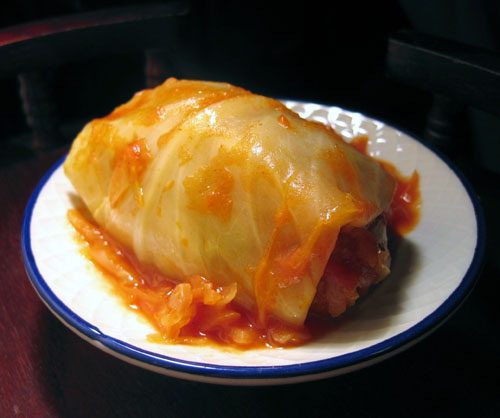10 Nov 2006
Töltött Káposzta (Stuffed Cabbage)

Ingredients
1 cabbage (the typical green thick-leafed kind you find in the US)
for the filling
- 1 lb. ground beef
- 1/2 lb. rice, rinsed
- 1 large onion, finely chopped
- 1 tbsp édes paprika
- A little olive oil, just to help bind it together
- Salt and black pepper to taste
for the sauce
- 15 oz. sauerkraut (this is 1 jar, usually)
- Water
- Oil
- 2 tbsp all-purpose flour
- 1 tsp édes paprika
- 1 tbsp granulated sugar
- Salt to taste
- 12 oz. tomato paste (this is 2 cans, usually)
Directions
-
Take off the most wretched outer leaves of the cabbage, and rinse the whole thing off. Steam the cabbage for 5-10 minutes, or until the leaves are pliable enough to bend easily. I find that after removing all the pliable leaves I can, I end up having to re-steam the still hard inner leaves. If I steam it so long that even they are pliable from the start, the outer leaves are easier to accidentally rip.
-
Peel off the leaves. Hold each leaf rib-side up, and pare the thick rib down to get rid of that tough vein and make it about as flat as the rest of the leaf.
-
Prepare the filling by mixing all the filling ingredients together by hand. The rice:meat ratio varies, though I have suggested using a 1:2 ratio here. Ima initially told me to use 1 part rice to 1 1/2 parts meat by weight, but when I tried it that way, there was way more rice than I’m used to when she cooks it. It may be that the type of rice used affects this – I don’t know what sort of rice Ima uses (Uncle Ben’s would be my guess), but I use basmati. Szaz Anna also uses 1 part rice to 1 1/2 parts meat by weight.
-
To fill each cabbage leaf, set the leaf on the table rib-side down, so that it naturally curves into a sort of cup waiting to be filled. Roll small handfulls of meat into oblong patties that fit the size of the leaves, and place the filling on the cabbage leaf, near the bottom of the leaf. Fold the sides of the leaf over the filling, and roll the cabbage around the meat, being sure to tuck the bottom end of the rib around the filling to keep it all snugly wrapped.
-
Cut the center out of the cabbage that remains, and discard. Chop up the rest of the cabbage into small pieces.
-
To fill the pot, start with a layer of that chopped up cabbage mixed with sauerkraut. Then place the stuffed cabbage in a flat layer on top of that, starting by lining them up around the circumference of pot and then filling in the middle. Add another layer of chopped cabbage and sauerkraut on top of that, then another layer of stuffed cabbage. Keep going like this until you run out of stuffed cabbage, and add a final layer of chopped cabbage and sauerkraut on top. Add water to just cover the contents of the pot.
-
Bring it to a boil, then reduce to a simmer. Simmer, covered, for about 30 minutes.
-
A few minutes before your kitchen timer goes off, make a roux by browning the flour in a bit of oil in a separate pan. Stir in the paprika, then remove from heat. Add the sugar, salt, and tomato paste, and mix well. Ladle some of the water out of the cooking cabbage pot and mix in with the paste, just to thin it out. Add the thinned paste back into the pot with the cabbage, and carefully stir it in to dissolve it in the water. My grandmother instructed me to the shake the pot to get the paste mixed in, but my pot was too full for me to risk that.
-
Simmer for another 10-20 minutes, or until done.
Notes
-
The rice:meat ratio varies depending on who you ask, though I have suggested using a 1:2 ratio here. Ima initially told me to use 1 part rice to 1 1/2 parts meat by weight, but when I tried it that way, there was way more rice than I’m used to when she cooks it. It may be that the type of rice used affects this – I don’t know what sort of rice Ima uses (Uncle Ben’s would be my guess), but I use basmati. Szaz Anna also uses 1 part rice to 1 1/2 parts meat by weight. When I called Ima to ask her to clear this up for me, she explained that it is really based on what you can afford – if you can afford more meat, use less rice. If you want to stretch the meat further, use more rice. The rice also serves the purpose of keeping the meat from binding into nothing more than a tough patty; like the bread in meatballs, the rice here keeps the meat tender and good.
-
You can skip the roux if this needs to be gluten-free. The sauce’ll be a bit thinner but the world won’t end.
-
When I’m lazy I sometimes just make this as meatballs and chopped up cabbage. It all tends to fall apart into mush, gotta tweak it somehow to bind together better without the wrappers but I haven’t bothered because I don’t really mind eating bowls of delicious mush.
